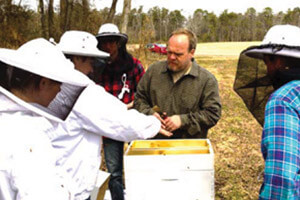
“That dichotomous choice is exactly the problem – it’s not dichotomous. ‘Treatment’ is assumed to mean using synthetic acaricides. We need to use the words ‘control’ or ‘mitigation’. The opposite is not doing anything.”
David Tarpy
The mite. Beekeepers don’t need to specify which of the 48,200 known mite species, even though there are 86 different mites that live with bees, mostly scavengers. For all, the one is Varroa destructor, but beyond that there is not even agreement that something has to be done about it.
One entomologist considers the mites a strategically useful selective pressure and advertises to buy them. Conversely, an epidemiologist considers them an epidemic to quell.
The first is John Kefuss, who recently published a scientific paper in The Journal of Apicultural Research on successful breeding for resistance by not treating in his commercial operation.1 He calls his approach to mites The Bond Method – “live and let die.”
The second is Dennis vanEngelsdorp, a professor at the University of Maryland and project director for the nation-wide Bee Informed Project (BIP).2 He concludes that untreated colonies can generate mites – a phenomenon he illustrates with a film clip of a hydrogen bomb blast.
What seems at first take to be a standoff is not as intractable as it seems. Kefuss sees a role for treatment and vanEngelsdorp supports non-chemical management practices. Neither is binary; both see what appears to be a dichotomy as parts of the same mission: As vanEngelsdorp puts it, “This is the long term solution: we need bees that are resistant to mites.”
Evidence for gaming the mite-bee relationship is still being painstakingly gathered, and gaps hint at unknown others. Entomologist Dave Tarpy said, as a scientist “You have to feel comfortable feeling stupid.” What he means is that a shedding of preconceptions can open new understanding.
An aside about definitions (already time to try on the stupid hat): The word for successful coexistence with a parasite, as Varroa does on A. m. cerana, is actually “tolerance.” However, the word “resistance”, which denotes elimination, has come to be used instead to describe the characteristics of bees that “keep Varroa destructor at a relatively low level” (Danka, Rinderer, Spivak, Kefuss, 20133). Hey, those are the experts, so that meaning will be used here. Just the same, it is widely agreed that the mite will not be completely eliminated but is here to stay (i.e. tolerated). The original meaning of “resistance” is retained in reference to chemicals, as in fluvalinate-resistant mites. Still there?
Scroll back in time when little was known about how to combat bee disease, let alone pests. In the 1930’s researcher O. W. Park saw bees uncapping cells to rid the hive of American foulbrood. In 1942, Woodrow and Holst reported observing the same behavior, with bees removing AFB spores in the latent, non-infectious state. W.C. Rothenbuhler picked up the research in the 50’s, coining the term “hygienic behavior.”
His idea was abandoned in favor of antibiotics, which were far less labor intensive than breeding for an elusive trait. And the Rothenbuhler stock, so carefully developed through inseminated lines to concentrate the foulbrood-resistant genes, is said to have collapsed from inbreeding – resistant to one disease but susceptible to another (a virus called hairless black syndrome). From the stupidity stance, this failure became a gift, a lesson for subsequent breeding lines to be strengthened with more diverse genetics.
It was widely believed at the time that a chemical approach could create effective controls. It made sense: Science had confronted human diseases such as …
Photo Caption
Dennis vanEngelsdorp (center) installs a package of bees. He heads the Bee Informed Partnership , a nation-wide project that has collected five years of beekeeping data. Photo courtesy of the Bee Informed Partnership.


